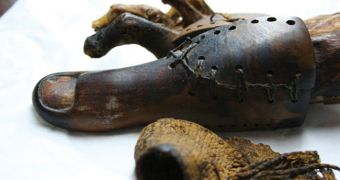We know that queen Hatshepsut wore false beard. But the ancient Egyptian technology went much further.
An artificial big toe discovered on the foot of an Egyptian mummy could be the world's oldest functioning prosthetic body part. Volunteers missing their right big toe will test replicas of the prosthesis to see how effective that really was. The mummy from the Cairo museum in Egypt was discovered in 2000 in a tomb close to the ancient city of Thebes.
The 50- to 60-year-old woman wearing the prosthesis could have lost her toe due to severe effects of diabetes.
The prosthesis is made of wood and leather and could date from 1069 to 664 B.C., as signaled by artifacts encountered within the mummy's burial chamber. In this case, it is older than the earliest known functioning prosthesis, the Roman Capua Leg, a bronze artifact dated to 300 B.C., and lost during the bombardment of the World War II on the Royal College of Surgeons in London.
Replicas of a second fake Egyptian right big toe are found at the British Museum in London, but they lack the mummy. They too will be tested.
This artifact, called the Greville Chester Great Toe after the collector who delivered it to the museum in 1881, is made from cartonnage, a type of papier mach? processed from linen, glue and plaster. The linen weaving technique points to a period between 1295 to 664 B.C.
"If either prosthesis aids walking or balance then the history of prosthetic medicine will be pushed back some 600 to 700 years and credited to the ancient Egyptians. If either one is functional it may be interesting to manufacture it with modern materials and trial it for use on people with missing toes," said Jacky Finch at the University of Manchester's KNH Centre for Biomedical Egyptology in England.
The Cairo toe appears to have been functional, as it has three joints "and shows signs of wear. It is still attached to the foot of the mummy of a female between 50 and 60 years of age. The amputation site is also well healed.", said Finch.
The London toe also displays signs of having been worn, maybe by its owner in life, and not simply attached to the foot after death for religious or ceremonial reasons. Still, this specimen does not bend and it could have been just for cosmetic purposes. The ancient Egyptians often re-built artificial body parts to corpses, so that many prostheses were not practical. "The theology of Osiris, the god of the dead, stated that the body, in order to be effective during the afterlife, should be complete. Osiris himself, according to myth, was cut up and his body parts scattered and later reunited." explained Finch.
Many artificial body parts were found on the ancient Egyptian mummies, like feet, legs, noses, ears and even penises. "You were still able to procreate in the afterlife," Finch told LiveScience.

 14 DAY TRIAL //
14 DAY TRIAL //